The Causes Behind Canine Influenza

- posted: Feb. 19, 2023
Coughing, sneezing, and a runny nose are just some symptoms that can indicate your pup has the flu. While some of these signs may be similar to what humans experience with the common cold, canine influenza is much more serious. To help you better understand this contagious virus, let’s explore what causes flu in dogs.
The Causes of Canine Influenza
Canine influenza is caused by two different strains of the virus, known as H3N2 and H3N8. It’s believed that both strains jumped from birds to horses before making their way over to canine species in 2004 and 2008, respectively. Although bird flu viruses have been around for centuries, it wasn’t until recently that they began infecting other animal species.
Transmission & Infection
Dogs contract canine influenza through direct contact with an infected dog or by coming into contact with objects contaminated by an infected pup, such as food bowls and toys. Like humans, dogs can also acquire the virus through airborne droplets from an infected dog’s cough or sneeze.
Puppies younger than six months old are more prone to infection because their immune systems are still developing, but older dogs can become sick, too—especially those who haven’t been vaccinated. Some breeds including Greyhounds and Bulldogs are also at higher risk for contracting the virus due to their short muzzles, making it easier for them to spread germs through their respiratory system when coughing or sneezing.
Prevention & Treatment
The good news is that there is a vaccine available to help protect your pet against canine influenza if they come into contact with other pups or go to places like dog parks or pet daycares where they’re exposed to many different animals at once.
Additionally, regular vet check-ups can help identify any signs of illness early on so treatment can begin quickly before the virus turns into something more serious, like pneumonia or bronchitis.
If your pup comes down with the flu, antibiotics will likely be prescribed along with plenty of rest and fluids to recover quickly and safely back home with you!
Conclusion
Taking proper preventative measures will go a long way toward keeping your pup safe from canine influenza. Vaccines should be administered regularly, and vet check-ups should often occur so any signs of an illness can be caught early before things worsen significantly. With the right care plan, you can rest assured that your furry companion will remain healthy this season!

- posted: Feb. 19, 2023
Coughing, sneezing, and a runny nose are just some symptoms that can indicate your pup has the flu. While some of these signs may be similar to what humans experience with the common cold, canine influenza is much more serious. To help you better understand this contagious virus, let’s explore what causes flu in dogs.
The Causes of Canine Influenza
Canine influenza is caused by two different strains of the virus, known as H3N2 and H3N8. It’s believed that both strains jumped from birds to horses before making their way over to canine species in 2004 and 2008, respectively. Although bird flu viruses have been around for centuries, it wasn’t until recently that they began infecting other animal species.
Transmission & Infection
Dogs contract canine influenza through direct contact with an infected dog or by coming into contact with objects contaminated by an infected pup, such as food bowls and toys. Like humans, dogs can also acquire the virus through airborne droplets from an infected dog’s cough or sneeze.
Puppies younger than six months old are more prone to infection because their immune systems are still developing, but older dogs can become sick, too—especially those who haven’t been vaccinated. Some breeds including Greyhounds and Bulldogs are also at higher risk for contracting the virus due to their short muzzles, making it easier for them to spread germs through their respiratory system when coughing or sneezing.
Prevention & Treatment
The good news is that there is a vaccine available to help protect your pet against canine influenza if they come into contact with other pups or go to places like dog parks or pet daycares where they’re exposed to many different animals at once.
Additionally, regular vet check-ups can help identify any signs of illness early on so treatment can begin quickly before the virus turns into something more serious, like pneumonia or bronchitis.
If your pup comes down with the flu, antibiotics will likely be prescribed along with plenty of rest and fluids to recover quickly and safely back home with you!
Conclusion
Taking proper preventative measures will go a long way toward keeping your pup safe from canine influenza. Vaccines should be administered regularly, and vet check-ups should often occur so any signs of an illness can be caught early before things worsen significantly. With the right care plan, you can rest assured that your furry companion will remain healthy this season!
The Melrose Vet
8304 Melrose Ave,
Los Angeles, CA 90069
